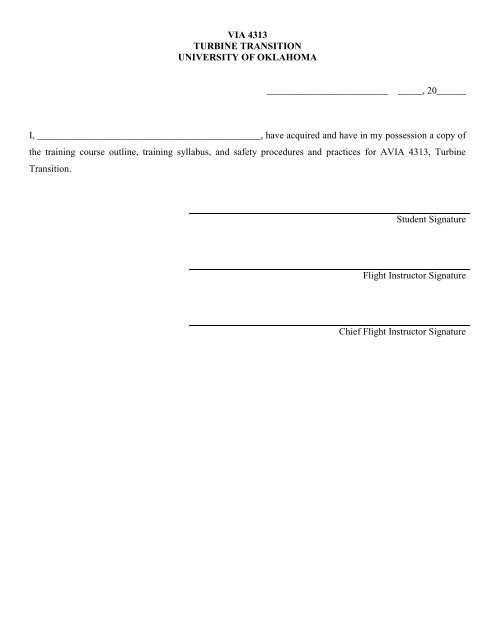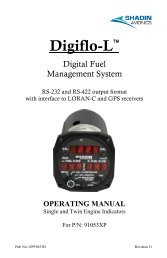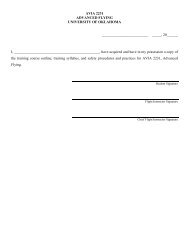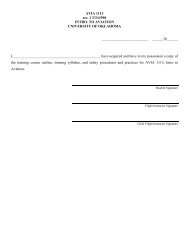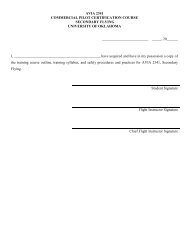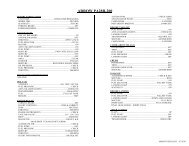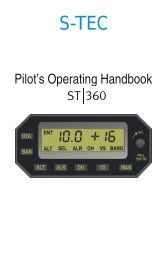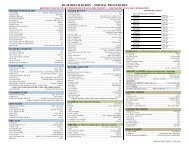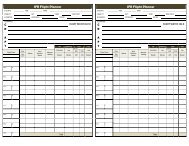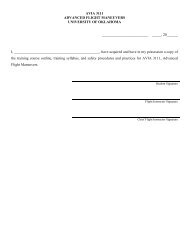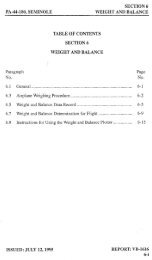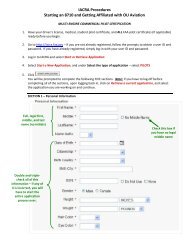AVIA 4313 - Turbine Transition - OU Aviation - University of Oklahoma
AVIA 4313 - Turbine Transition - OU Aviation - University of Oklahoma
AVIA 4313 - Turbine Transition - OU Aviation - University of Oklahoma
You also want an ePaper? Increase the reach of your titles
YUMPU automatically turns print PDFs into web optimized ePapers that Google loves.
VIA <strong>4313</strong>TURBINE TRANSITIONUNIVERSITY OF OKLAHOMA_________________________ _____, 20______I, ______________________________________________, have acquired and have in my possession a copy <strong>of</strong>the training course outline, training syllabus, and safety procedures and practices for <strong>AVIA</strong> <strong>4313</strong>, <strong>Turbine</strong><strong>Transition</strong>.Student SignatureFlight Instructor SignatureChief Flight Instructor Signature
UNIVERSITY OF OKLAHOMATURBINE TRANSITIONTURBINE TRANSITION 3LESSON DESCRIPTION AND STAGES OF TRAINING: Each lesson is fully described within thesyllabus, including the objectives, standards, and measurable units <strong>of</strong> accomplishment and learning. You areexpected to complete at least one stage approximately every 90 days. The stage objectives and standards aredescribed at the beginning <strong>of</strong> each stage within the syllabus.C<strong>OU</strong>RSE POLICY: The course policies for this course <strong>of</strong> training are outlined in Appendix B <strong>of</strong> this TrainingCourse Outline.TESTS AND CHECKS: The syllabus incorporates stage checks in accordance with FAR 141, Appendix F.These checks are given by the chief instructor or the designated assistant at the end <strong>of</strong> each stage. You willcomplete the appropriate stage exams, oral briefings, and final examinations described in the syllabus.
UNIVERSITY OF OKLAHOMATURBINE TRANSITIONRULES OF OPERATIONSTURBINE TRANSITION 5APPROVAL FOR RETURN OF AIRCRAFT TO SERVICE: The mechanics will take whatever correctiveactions are required to return the aircraft to service. Upon returning the aircraft to service the mechanics willplace the "Maintenance Required" sign back in the lose leaf notebook and notify the main <strong>of</strong>fice. At that timethe plastic flight plan will be turned back over and the yellow copy <strong>of</strong> <strong>OU</strong>AVMAIN #2 placed in the mechanicsin-box. If the discrepancy can't be corrected immediately, but the mechanics determine the aircraft is stillairworthy, this information will be noted in the "Maintenance Performed" section along with any requiredoperating limitations due to the discrepancy. Inoperative equipment will be removed or deactivated andplacarded IAW 14 CFR, Section 91.213. If the MEL permits, the aircraft may then be returned to service andflown within any operating limitations required by the MEL.SECURING AIRCRAFT - The pilot in command is responsible for securing aircraft on the ramp. Onlyaviation department personnel and contract personnel from the FBO may hangar aircraft. Students may assist inhangaring aircraft under the supervision <strong>of</strong> these personnel. All university aircraft will be secured with tie-downropes or chocks while unattended on the Department <strong>of</strong> <strong>Aviation</strong> ramp. On cross country flights, the pilot incommand will make tie-down arrangements with the local FBO for securing the aircraft. At no time will anaircraft be left unattended without it being secured by wheel chocks or tie-down ropes. When returning aircraftto the ramp in front <strong>of</strong> the terminal, solo students will not park the aircraft in the first row by the fence.AIRCRAFT AVOIDANCE - No person may operate an aircraft so close to another aircraft as to create acollision hazard either on the ground or in the air. At all times, the Pilot-in-Command will be responsible for,and actively use "See and Avoid" procedures as described in the AIM, Chapter 7, Section 5 and comply with theright <strong>of</strong> way rules specified in 14 CFR, Section 91.113.FUEL RESERVES - At no time will a department aircraft depart on a flight without the minimum fuelrequired by 14 CFR, Section 91.151 for VFR flights or 91.169 for IFR flights.MINIMUM ALTITUDES - Minimum altitude for instrument training under VFR with the exception <strong>of</strong>landing practice is 600' AGL or higher if the minimum altitude applicable in 14 CFR, Section 91.119 is higherthan 600' AGL. Minimum altitudes for IFR operations will be in accordance with 14 CFR, Sections 91.175 and91.177. Minimum altitude for failing an engine and feathering its propeller is 3000 feet AGL. At altitudes lowerthan 3000 feet AGL, engine failures will be simulated by reducing torque and feather will be simulated byestablishing zero thrust (100 ft-lbs torque, 1800 RPM). Simulated engine failures will be initiated above 500feet AGL.PRACTICE AREAS - The <strong>University</strong> utilizes several practice areas for flight training. These areas aredepicted in Appendix C <strong>of</strong> this Training Course Outline.WEATHER MINIMUMSInstrument training under VFR will be in accordance with the basic VFR weather minimums in 14 CFR,Section 91.155. For IFR operations, minimum weather for landings will be in accordance with 14 CFR, Section91.175. For take<strong>of</strong>fs, the ceiling and visibility will be equal to or greater than the lowest Category A aircraftinstrument approach minimums at the departure airport. If prevailing winds dictate a circling procedure, thelowest Category A circling minimums will apply. Determination <strong>of</strong> the requirement for an alternate airport willbe in accordance with 14 CFR, Section 91.169.
UNIVERSITY OF OKLAHOMATURBINE TRANSITIONRULES OF OPERATIONSTURBINE TRANSITION 6WIND LIMITS:Dual:Crosswind:Maximum 35 knots - Maximum 15 knots gust spreadCrosswind limits will not exceed those specified by the Pilots Operating Handbook forthe aircraft to be flown.AIRCRAFT CHECKLIST/KEY TURN IN: After completing the flight and securing the aircraft, the studentwill record the hobbs time on the Aircraft Information Sheet and return the aircraft checklists and keys to thedispatch area. Give the keys to a staff member for return to the lock box and complete the information on theAircraft Sign Out Sheet. Return the syllabus sheet to the instructor for further processing.ATTENDANCE - TARDINESS:Students are expected to attend all scheduled ground and flight training lessons. In the event <strong>of</strong> sickness oraccident, call the <strong>Aviation</strong> Department at 325-7231. Do not make a determination <strong>of</strong> attendance dueto weather. If in doubt, call the <strong>Aviation</strong> Department. Excessive absences or tardiness, are grounds for removalfrom the course.
UNIVERSITY OF OKLAHOMATURBINE TRANSITIONGR<strong>OU</strong>ND TRAINING AND READING ASSIGNMENTSTURBINE TRANSITION 7STAGE LESSON ASSIGNMENTS H<strong>OU</strong>RS1- TPFM Chapter 3- KASM, Ch 73.0- TPFM, Chapter 323.0- KASM, Chapter 7STAGE I- TPFM, Chapter 43 - KASM, Chapter 23.0- KAPOH, Sections 4 & 54 Review & Exam 1.01- TPFM, Chapter 4- KASM, Chapter 91.52- TPFM, Chapter 5- KASM, Chapter 151.5STAGE II3- AIM, Chapter 8,- TPFM, Chapter 5- KASM, Chapters 11 & 12 &163.0- KAPOH, Sections 4 & 54- TPFM, Chapter 5- KASM, Chapter 51.5- KAPOH, Sections 4 & 55 Review & Exam 1.0- TPFM, Chapter 61 - KASM, Chapter 101.5- KAPOH, Sections 4 & 52- TPFM, Chapter 6- KASM, Chapters 4 and 141.5STAGE III- KAPOH, Sections 4 & 53- TPFM, Chapters 7 & 10- KAPOH, Sections 2 & 53.04- TPFM, Chapter 11- KAPOH, Section 61.55 Review & Exam 1.0- TPFM, Chapter 141 - KASM, Chapter 161.5- KAPOH, Avionics Supplement2- TPFM, Chapter 13- KASM, Chapter 163.0STAGE IV- KAPOH, Avionics Supplement3- TPFM, Chapter 9- KAPOH, Sections 3 & 41.54 - TPFM, Chapter 15 1.55 - TPFM, Chapter 16 1.56 Review & Exam 1.0TOTALS 33.0 4.0Note: The readings referred to in this syllabus are based on The <strong>Turbine</strong> Pilots Flight Manual (TPFM), King AirSystems Manual (KASM), King Air POH (KAPOH) and the Aeronautical Information Manual (AIM). Thehours designated for each lesson are suggested guidelines only, and may vary at the instructor’s discretion. Inno case will the total hours <strong>of</strong> instruction be less than the total number <strong>of</strong> hours defined in this syllabus.
STAGE ITURBINE TRANSITION 8STAGE OBJECTIVEDuring this stage, the student will be introduced to the various types <strong>of</strong> gas generators, turb<strong>of</strong>ans, andturboprops, along with the different types <strong>of</strong> thrust reversers. Additionally, the student will obtain knowledge <strong>of</strong>the various propeller systems. The student will also become familiar with the various types <strong>of</strong> electricalsystems. The student will also become knowledgeable about the BE90 engines, propeller system and electricalsystem.STAGE COMPLETION STANDARDThis stage is complete when the student has taken the Stage I written exam with a minimum passing score <strong>of</strong>70%, and the instructor has reviewed each incorrect response to ensure complete understanding before thestudent progresses to Stage II.
STAGE I, GR<strong>OU</strong>ND LESSON 1TURBINE TRANSITION 9TEXT REFERENCE: See Ground Training and Reading AssignmentsLESSON OBJECTIVE: During this lesson, the student is introduced to gas generators, turb<strong>of</strong>ans, andturboprops, along with the various types <strong>of</strong> thrust reversers. The student is also introduced to the BE90turboprop engine.CONTENT:Gas <strong>Turbine</strong> Engines- gas generators- compressors- turbinesCompressors- centrifugal flow- axial flowMulti Stage/Multi Spool Engines- low pressure turbines- N1 Shaft≅- high pressure turbine- N2 Shaft≅Turbojet Engines- principles <strong>of</strong> operations- advantages- disadvantagesTurb<strong>of</strong>an Engines- principles <strong>of</strong> operations- advantages- disadvantagesTurboprop Engines- principles <strong>of</strong> operation- direct-drive turboprop- free-turbine turbopropEngine Operating Parameters- engine pressure ratios (EPR)- exhaust gas temperatures (EGT)- interstage turbine temperatures (ITT)<strong>Turbine</strong> Engine Starting- hot start- ignitersThrust Reversers- purpose- types used on jets-clamshell-cascade-petal door- reverse thrust on turboprops- use <strong>of</strong> reversersBE90 Engines- Gas Generation Module- Power Module- Engine Gauges- Engine Controls- Engine Limitations- Starting ProceduresCOMPLETION STANDARDS:The student will exhibit knowledge <strong>of</strong> turbine engines in general and BE90 engines in particular through guideddiscussion before progressing to lesson 2.
STAGE I, GR<strong>OU</strong>ND LESSON 2TURBINE TRANSITION 10TEXT REFERENCE: See Ground Training and Reading AssignmentsLESSON OBJECTIVE:During this lesson, the student learns the various types <strong>of</strong> propeller systems found on turbine aircraft.Additionally, the student will become thoroughly familiar with the propeller system found on the BE90. Thestudent will also review basic multi-engine aerodynamics including critical engine concepts and V-speeds.CONTENT:Multi-engine Aerodynamics Review- Critical Engine- Vmc and Factors Affecting Vmc- Vyse and Factors Affecting Vyse- Impact on Performance When Shutting Down an EngineTurboprop Propeller Systems- Propeller Controls and Governors- primary governor- overspeed governor- fuel topping governor- Beta governor- Propeller Auto-Feather System- Propeller SynchrophasersBE90 Propeller System- Propeller Controls- Governor Systems- Auto-Feather System- Synchophaser System- Propeller Systerm ChecklistsCOMPLETION STANDARDS:The student will exhibit thorough knowledge <strong>of</strong> multi-engine aerodynamics, the various types <strong>of</strong> propellersystems and terminology as well as the BE90 propeller system through guided discussion before continuing tothe next lesson.
STAGE I, GR<strong>OU</strong>ND LESSON 3TURBINE TRANSITION 11TEXT REFERENCE: See Ground Training and Reading AssignmentsLESSON OBJECTIVE:During this lesson, the student will learn the basic principles <strong>of</strong> powered aircraft systems, basic electrical systemconcepts and the electrical system <strong>of</strong> the BE90.CONTENT:Basics <strong>of</strong> Aircraft Power Systems (Source, Supply, Storage, Transmission, Output Devices, Directional Controland Regulation)Electrical Power Sources- Generator - Direct Current(DC) vs. Alternating Current(AC)- Battery - Ni-cad vs. Lead AcidTransmission and GroundingControl Devices- Generator Control Units (GCU)- Relays- SolenoidElectrical Conversion Devices- Transformer-Rectifier Units (TRU)- InvertersElectrical Faults- Shorts- Opens- LogicCircuit Protection Devices- Circuit Breakers- Current Limiters and Fuses- Diodes- Hall Effect DevicesBus Bar Systems- Battery Bus- Hot Bus- AC and DC Busses- Bus Ties and Bus IsolationBE90 Electrical System- Battery- Starter/Generator- Bus Bar System- Circuit Breakers- Controls and Gauges- Electrical System ChecklistsCOMPLETION STANDARDS:The student will demonstrate thorough knowledge <strong>of</strong> the basic concepts <strong>of</strong> aircraft power systems, electricalsystems in general and the BE90 electrical system through a guided discussion before progressing to the nextlesson.
STAGE I, GR<strong>OU</strong>ND LESSON 4 STAGE I EXAMTURBINE TRANSITION 12LESSON OBJECTIVE:This exam evaluates the student’s comprehension <strong>of</strong> the material presented in Stage I.CONTENT:Stage I ExamCOMPLETION STANDARDS:This lesson and stage are complete when the student has completed the exam with a minimum passing score <strong>of</strong>70%, and the instructor has reviewed the exam with the student to ensure complete understanding beforeprogressing to the next stage.
STAGE IITURBINE TRANSITION 13STAGE OBJECTIVEDuring this stage, the student will be introduced to the various hydraulic systems, control inputs, andpressurization and fuel systems found with turbine aircraft. The student will also receive thorough knowledge <strong>of</strong>the related systems for the BE90.STAGE COMPLETIONThis stage is complete when the student has taken the Stage II written exam with a minimum passing score <strong>of</strong>70%, and the instructor has reviewed each incorrect response to ensure complete understanding before thestudent progresses to Stage III.
STAGE II, GR<strong>OU</strong>ND LESSON 1TURBINE TRANSITION 14TEXT REFERENCE: See Ground Training and Reading AssignmentsLESSON OBJECTIVE:During this lesson, the student is introduced to turbine aircraft hydraulic systems as well as the variouspneumatic systems. The student will also receive a thorough understanding <strong>of</strong> the related systems in the BE90.CONTENT:Hydraulic Power Systems- Hydraulic Pumps- Hydraulic Motors- Hydraulic Cylinders- Hydraulic Lines- Valves- Reservoirs- Hydraulic AccumulatorsPneumatic Power Systems- High-Pressure Bleed Air- Pressure Regulator- Low-Pressure Air- Equipment that uses low pressure airAuxiliary Power UnitsBE90 Hydraulic Systems- Landing Gear- BrakesBE90 Pneumatic System- Bleed Air- Vacuum Ejector- Instruments- Door Seal- Wing Deice- Ruder BoostCOMPLETION STANDARDS:The student will exhibit knowledge <strong>of</strong> the hydraulic and pneumatic systems and Auxiliary Power Units as wellas the BE90 hydraulic and pneumatic systems through a guided discussion before continuing to the next lesson.
STAGE II, GR<strong>OU</strong>ND LESSON 3TURBINE TRANSITION 16TEXT REFERENCE: See Ground Training and Reading AssignmentsLESSON OBJECTIVE:In this lesson, the student will be introduced to high altitude physiology, pressurization and environmentalsystems found with turbine aircraft. In addition, the student will learn the specific pressurization andenvironmental control systems on the BE90.CONTENT:High Altitude Physiology- Environment at High Altitude (Pressure and Temperature)- Respiration- Effects <strong>of</strong> Prolonged Use <strong>of</strong> Supplemental Oxygen- Hypoxia (Causes, Symptoms, Effect On the Body- Time Of Useful Consciousness, Corrective Actions)- Trapped Gas (Causes, Symptoms, Effect On the Body, Corrective Actions)- Evolved Gas (Causes, Symptoms, Effect On the Body, Corrective Actions)Pressurization-Components (Pressure Vessel, Air Source, Exhaust Valve, Safety Valve)- Indicators (Cabin Altitude, Cabin Rate <strong>of</strong> Climb, Pressure Differential)- High Cabin Altitude Warming System and Indicator- Pressure Controller Operation (Altitude and Rate <strong>of</strong> Climb)- Emergency Situations - Rapid DecompressionEnvironmental Systems- Heat Exchangers- Air Cycle Machines (ACM)- Vapor Cycle Machines (VCM)BE90 Pressurization and Environmental Systems- Air Sources (Bleed Air and Ram Air)- Basic Plumbing (Heat Exchangers, VCM and Electric Heating Unit)- Operation <strong>of</strong> Pressure Controller- Operation <strong>of</strong> Environmental Controls (Automatic Mode Control, Manual Mode Control, BleedAir Control, Vent Blower Control, Pilot/Copilot Air and Defrost Control Knobs- System Checks- Supplemental Oxygen SystemCOMPLETION STANDARDS:The student will exhibit knowledge <strong>of</strong> high altitude physiology, pressurization and environmental systems <strong>of</strong>turbine aircraft as well as the pressurization and environmental systems <strong>of</strong> the BE90 through a guideddiscussion before continuing to the next lesson
STAGE II, GR<strong>OU</strong>ND LESSON 5 STAGE II EXAMTURBINE TRANSITION 18LESSON OBJECTIVE: This exam evaluates the student’s comprehension <strong>of</strong> the material presented in StageII.CONTENT:Stage II ExamCOMPLETION STANDARDS:This lesson and stage are complete when the student has completed the exam with a minimum passing score <strong>of</strong>70%, and the instructor has reviewed the exam with the student to ensure complete understanding beforeprogressing to the next stage
STAGE IIITURBINE TRANSITION 19STAGE OBJECTIVEDuring this stage, the student will gain knowledge <strong>of</strong> various methods <strong>of</strong> ice and rain protection, landing gearsystems, annunciator systems, fire protections systems as well as limitations, determining performance andweight and balance in turbine aircraft.STAGE COMPLETION STANDARDSThis stage is completed when the student has taken the Stage III written exam with a minimum passing score <strong>of</strong>70%, and the instructor has reviewed each incorrect response to ensure complete understanding before thestudent progressed to Stage IV.
STAGE III, GR<strong>OU</strong>ND LESSON 1TURBINE TRANSITION 20TEXT REFERENCE: See Ground Training and Reading AssignmentsLESSON OBJECTIVE: During this lesson the student will review environmental factors leading to theformation <strong>of</strong> structural icing, type <strong>of</strong> structure icing, impact <strong>of</strong> structural icing on control and performance anddanger <strong>of</strong> using the autopilot during flight in icing conditions. The student learns the methods <strong>of</strong> ice and rainprotection with turbine aircraft as well as the ice and rain protection systems in the BE90CONTENT:Icing Review- Types <strong>of</strong> Structural Icing and Environmental Factors Causing Its Formation- Impact <strong>of</strong> Structural Icing on Control and Performance- Dangers <strong>of</strong> Autopilot Usage During Icing ConditionsIce Protection- De-Ice vs. Anti-Ice- Ground Icing (Type I, II and IV)- Structural (Boots, Bleed Air Thermal, Liquid - Weeping Wing)- Propeller (Electric Boots)- Engine (Inlet and Inertial Separators)- Fuel System (Additives, Heat Exchangers, electric vent heaters)- Windshield (Electric, Heated Air-Defrost, Liquid)- Pitot/Static and Stall WarningRain Protection- Windshield (Wipers and Chemical Treatment)- Engine (Auto-Igniters)Pilot’s Role in Operations <strong>of</strong> De-Ice/Anti-Ice SystemsBE90 Ice/Rain Protection Systems (Including Controls, Annunciators, Gauges)- Engines (Ice Vanes, Auto-Ignition, Engine Air Inlet Lip Heat)- Structure (Boots and Wing Ice Lights- Fuel System (Prist, oil-to-fuel heat exchanger – fuel controller, electric fuel vent heat)- Propellers (electric boots)- Windshield (electric heat, defrost and wipers)- Pitot/Static and Stall WarningCOMPLETION STANDARDS:The student will exhibit adequate knowledge structural icing dangers, systems available for ice and raingprotection and ice and rain protection systems on the BE90 through a guided discussion before continuing to thenext lesson.
STAGE III GR<strong>OU</strong>ND LESSON 2TURBINE TRANSITION 21TEXT REFERENCE: See Ground Training and Reading AssignmentsLESSON OBJECTIVE: During this lesson, the student learns about the landing gear systems, annunciator andwarning systems, and about fire protection systems. The student will become familiar with the related subjectsdealing with the BE90.CONTENT:Landing Gear Systems- Gear Squat Switchs- Emergency Gear Extensions- Brakes and Anti-skid System- Nosewheel SteeringAnnunciator and Warning Systems- Annunciator or Advisory Panels (Warning, Caution and Status Lights)Fire Protection Systems- Fire Detection and Extinguishing Systems- Cockpit Controls- Cabin and Cockpit Protection- Fuel Tank- Cargo HoldBE90 Landing Gear, Steering and Brake Systems- Gear Operation and Controls (Status Lights, Unsafe Light/Horn, Hydraulic Fluid Light/Test- Steering (Operation, Use <strong>of</strong> Control Lock)- Brakes (Operation, Parking Brake)BE90 Annunciator PanelCOMPLETION STANDARDS:The student will exhibit adequate knowledge <strong>of</strong> the landing gear systems, annunciator and warning systems, firedetection and extinguishing systems found with turbine aircraft as well as these systems on the BE90 throughguided discussion before continuing to the next lesson.
STAGE III, GR<strong>OU</strong>ND LESSON 3TURBINE TRANSITION 22TEXT REFERENCE: See Ground Training and Reading AssignmentsLESSON OBJECTIVE: This lesson introduces the student to Limitations and performance factors dealingwith turbine aircraft. The student will also learn the limitations and how to determine performance for theBE90.CONTENT:Limitations- Airspeeds- Engines- Other SystemsTake<strong>of</strong>f and Climb Performance- V1 (Take<strong>of</strong>f Decision Speed)- VR (Rotation Speed)- V2 (Minimum Take<strong>of</strong>f Safety Speed)- Engine Out ClimbEn route Engine Out PerformanceLanding Performance- VREF (Landing Reference Speed)- Braking PerformanceRoutine Performance Planning- TOLD Cards- Airport Analysis TablesCruise Performance: Fuel PlanningBE90 Limitations- Airspeeds- Engines- Other SystemsBE90 Performance- Take<strong>of</strong>f- Climb- Enroute- Descent- Landing- Single-EngineCOMPLETION STANDARDS:The student will exhibit thorough knowledge <strong>of</strong> limitations and performance factors dealing with turbineaircraft as well as limitations and computation <strong>of</strong> performance in the BE90 through guided discussion beforecontinuing to the next lesson.
STAGE III, GR<strong>OU</strong>ND LESSON 4TURBINE TRANSITION 23TEXT REFERENCE: See Ground Training and Reading AssignmentsLESSON OBJECTIVE: During this lesson, the student learns the various weight and balance considerationswith turbine aircraft. The student will also learn how to compute the weight and balance for the BE90.CONTENT:Weight and Balance Terminology- Maximum Ramp Weight- Maximum Zero-Fuel Weight (MZFW)- Maximum Take<strong>of</strong>f Weight (MTOW)- Maximum Landing Weight (MLW)- Fuel Dump Valves- Aircraft Weight Categories- Percent MACWeight and Balance Considerations- CG as Percent MAC- Aft CG Advantages- In-flight CG ShiftDetermining Weight and Balance in the BE90COMPLETION STANDARDS:The student will exhibit adequate knowledge <strong>of</strong> weight and balance terminology and the considerations dealingwith turbine aircraft and how to determine weight and balance in the BE90 through guided discussions.
STAGE III, GR<strong>OU</strong>ND LESSON 5 STAGE III EXAMTURBINE TRANSITION 24LESSON OBJECTIVE: This exam evaluates the student’s comprehension <strong>of</strong> the material presented in StageIIICONTENT:Stage III ExamCOMPLETION STANDARDS:This lesson and stage are complete when the student has completed the exam with a minimum passing score <strong>of</strong>70%, and the instructor has reviewed the exam with the student to ensure complete understanding beforeprogressing to the next stage.
STAGE IVTURBINE TRANSITION 25STAGE OBJECTIVEDuring this stage, the student will be introduced to the performance factors, weight and balance, and theadvanced weather and navigation equipment found on turbine aircraft.STAGE COMPLETION STANDARDThis stage is complete when the student has taken the Stage IV written exam with a minimum passing score <strong>of</strong>70%, and the instructor has reviewed each incorrect response to ensure complete understanding.
STAGE IV, GR<strong>OU</strong>ND LESSON 1TURBINE TRANSITION 26TEXT REFERENCE: See Ground Training and Reading AssignmentsLESSON OBJECTIVE: During this lesson, the student is introduced to the various types <strong>of</strong> weather, terrainand traffic hazard warning systems found on turbine aircraft. In addition the student will learn the hazardavoidance systems on the BE90.CONTENT:Weather Avoidance Systems- Airborne Weather Radar- Storm scopes- Satellite Weather DownlinkTraffic Warning and Avoidance Systems – TCASGround Proximity Warning SystemsBE90 Hazard Avoidance Systems- Airborne Radar- Satellite Weather Downlink (Text and Radar)- TCAS- GPWSCOMPLETION STANDARDS:The student will exhibit thorough knowledge <strong>of</strong> hazard avoidance systems in general and the systems on theBE90 through a guided discussion prior to proceeding to the next lesson.
STAGE IV, GR<strong>OU</strong>ND LESSON 2TURBINE TRANSITION 27TEST REFERENCE: See Ground Training and Reading AssignmentsLESSON OBJECTIVE: During this lesson the student will be introduced to advanced GPS concepts andFlight Management Systems. Students will also learn the avionics, autopilot and flight directors system <strong>of</strong> theBE90.CONTENT:Advanced GPS Concepts- Wide Area Augmentation System (WAAS)- Local Area Augmentation System (LAAS)Flight Management Systems (FMS)- Basic Components (Flight Management Computer, Control Display Unit)- Basic Operation (Identification, Alignment, Route and Performance Pages)BE90 Avionics- Radios- Electronic ADI and HSI- Flight Director System- Autopilot System- Navigation equipment (GPS, VOR, ADF)- Multi-Function Display (MFD)COMPLETION STANDARDS:The student will demonstrate thorough knowledge <strong>of</strong> GPS WAAS and LAAS, FMS concepts as well as theavionics, autopilot and flight director systems <strong>of</strong> the BE90 through a guided discussion prior to proceeding tothe next lesson.
STAGE IV, GR<strong>OU</strong>ND LESSON 3TURBINE TRANSITION 28TEXT REFERENCE: See Ground Training and Reading AssignmentsLESSON OBJECTIVE: The student will learn checklist design and execution for abnormal and emergencysituations in turbine aircraft as well as the abnormal and emergency checklists for the BE90.CONTENT:Checklist Execution-- Memorized Items (Boldface)-- CleanupBE90 Abnormal and Emergency Procedures-- Abnormal (Air Start, Oil System, Nacelle Tank Switch Failure, Electrical AbnormalitiesAvionics Switch Failure, Landing Gear, Ice Protection, Static Air, Cracked Windshield-- Emergency (Airspeeds, Engine Failures, Fuel System, Smoke/Fumes, Electrical Fire,Emergency Descent, Flight Controls, Pressurization, Emergency Exit)COMPLETION STANDARDS:The student will demonstrate thorough knowledge <strong>of</strong> the philosophy behind abnormal and emergency checklistdesign and execution. The student will also demonstrate understanding <strong>of</strong> the abnormal and emergencyprocedures <strong>of</strong> the BE90 through a guided discussion.
STAGE IV, GR<strong>OU</strong>ND LESSON 4TURBINE TRANSITION 29TEXT REFERENCE: See Ground Training and Reading AssignmentsLESSON OBJECTIVE: The student will learn high altitude aerodynamics and IFR considerations for highaltitude operationsCONTENT:Aerodynamics <strong>of</strong> High-Speed/High Altitude Aircraft-- High-Speed and the Sound Barrier-- Swept Wing Aerodynamics-- Dutch Roll-- Winglets-- StallsHigh Altitude IFR Operations-- Pr<strong>of</strong>ile Descents-- Jet Routes-- Altimetry-- Reduced Vertical Separation Minimums (RVSM)COMPLETION STANDARDS:The student will demonstrate thorough knowledge <strong>of</strong> high altitude aerodynamics and IFR operations through aguided discussion prior to proceeding to the next lesson
STAGE IV, GR<strong>OU</strong>ND LESSON 5TURBINE TRANSITION 30TEXT REFERENCE: See Ground Training and Reading AssignmentsLESSON OBJECTIVE: The student will learn high altitude weather and its impact on turbine operations.The TropopauseThe Jet StreamCirrus CloudsClear Air TurbulenceCondensation TrailsThunderstormsCOMPLETION STANDARDSThe student will demonstrate thorough knowledge <strong>of</strong> high altitude weather and its impact on turbine operationsthrough a guided discussion.
STAGE IV, GR<strong>OU</strong>ND LESSON 6 STAGE IV EXAMTURBINE TRANSITION 31LESSON OBJECTIVE: This exam evaluates the student’s comprehension <strong>of</strong> the material presented in StageIV.CONTENT:Stage IV ExamCOMPLETION STANDARDS:This lesson and stage are complete when the student has completed the exam with a minimum passing score <strong>of</strong>70%, and the instructor has reviewed the exam with the student to ensure complete understanding.
FLIGHT TRAININGTURBINE TRANSITION 32LESSON DUAL INST DUAL XC DUAL PRE/POST FLIGHT1 1.5 1.02 2.0 1.0 1.0 1.03 1.5 1.0 1.0TOTAL 5.0 2.0 1.0 3.0*The individual lesson times shown on this table are for instructor/student guidance only, they are notmandatory for a given lesson. However, by the end <strong>of</strong> lesson 3, the total hour requirements in each category willbe met.During each lesson the instructor will also assume the role <strong>of</strong> non-flying pilot and will assist the student withexecution <strong>of</strong> checklists, radios and navigation.
FLIGHT LESSON 1LESSON OBJECTIVE: To develop the student’s skill in basicaircraft operations. The student will perform normal checklistsincluding normal starts and ground operations, as well as, basic airwork. The student will also be introduced to emergency descents andsingle engine landings.CONTENT:PREFLIGHT PREPARATION- Preflight- Performance Figures and LimitationsGR<strong>OU</strong>ND OPERATIONS- Before Engine Start- Engine Starting- Before Taxi- Taxi- Before Take<strong>of</strong>f- After Landing- Shutdown and SecuringAIR OPERATIONS- Normal Take<strong>of</strong>f and Climb- Turns- Minimum Controllable Airspeed- Imminent Stalls- Steep Turns- Single Engine Maneuvering- Emergency Descent- Normal Approach and Landing- Engine Failure During Take<strong>of</strong>f, Climb, Cruise and Approach to Landing- Single Engine Approach and LandingCOMPLETION STANDARDSAt the completion <strong>of</strong> this lesson the student will be able to perform allnormal checklists and engine failure checklists. During take<strong>of</strong>f andlanding the student will demonstrate good directional control. Lift<strong>of</strong>f,climb, approach, and touchdown speeds will be within 10KIAS <strong>of</strong> thatdesired. All other maneuvers will be done with +/- 150 feet <strong>of</strong> altitude,10 degrees <strong>of</strong> heading, +/- 10KIAS <strong>of</strong> that desired.TURBINE TRANSITION 33UNIVERSITY OF OKLAHOMASTUDENT NAME _______________________________ ID# _________________INSTRUCTOR NAME ____________________________ CERT# ______________AIRCRAFT # CRM 37 STAGE # TURBINE LESSON # 1SAT _____% UNSAT _____% INCOMPLETE ____% CANCELLATION________HOMEWORK COMPLETE: Y / N (% grade is normally part <strong>of</strong> the lesson grade.)Note:1. Circle appropriate status/grade and put number (%) grade on line.2. If cancellation state reason.REMARKS: __________________________________________________________FOR I OR U: SUBJECTS THAT ARE NOT COMPLETE/INSTRUCTOR COMMENTS________________________________________________________________________________________________________________________________________________________________________________________________________________________________________________________________________________FOR XC FLIGHTS, LIST DESTINATIONS: _________________________________Dl So Dnt Snt Dxc Sxc Idl Nldg AATD PC CA PP GI? ? ?DATE:__________________TIME: IN ________________ ENTERED BY _____________<strong>OU</strong>T ______________TOTAL ____________SYLL. LESSON ___________PROCESSED ON __________HOBBS: IN ________________ REMARKS: _______________<strong>OU</strong>T ______________TOTAL ______________________________________________________________STUDENT SIGNATURE ________________________________________________INSTRUCTOR SIGNATURE _____________________________________________
FLIGHT LESSON 2LESSON OBJECTIVE: To develop the student’s skill with crosscountry preparation and planning, high altitude operations, and flyingprecision and non-precision approaches. The student will plan a crosscountry flight <strong>of</strong> at least one hour duration. The remainder <strong>of</strong> this 2hour flight will then be available for instrument approaches. Thestudent will be able to identify abnormal and emergency situationspresented by the instructor and call for the appropriate checklist.CONTENT:LESSON REVIEW- Execution <strong>of</strong> checklists- Taxiing- Normal take<strong>of</strong>f and climb- Normal LandingsCROSS C<strong>OU</strong>NTRY PROCEDURES- Enroute Climb and Cruise (VR and IR)- Use <strong>of</strong> autopilot and flight director- Use <strong>of</strong> pressurization system- Use <strong>of</strong> flight director and autopilot- Use <strong>of</strong> De-Ice and Anti-Ice Systems- Use <strong>of</strong> Radar- Use <strong>of</strong> Multi-Function Display, Including Receipt <strong>of</strong> Weather Information- DescentTERMINAL PROCEDURES- Precision Approach – coupled (IR)- Non-Precision Approach (IR)- Single Engine Instrument Approach, Non-Precision (IR)- Normal Landing- Engine Shutdown and SecureCOMPLETION STANDARDSThe student will demonstrate knowledge <strong>of</strong> BE90 performance andlimitations in preflight planning. The student will perform the aircraftpreflight without assistance. The appropriate checklists will be calledfor and executed correctly. The student will demonstrate proper usage<strong>of</strong> aircraft systems and will correctly execute one precision and onenon-precision approach and a single engine non-precision approach.The student will maintain altitude +/- 100 feet and headings +/-100feet and airspeeds within +/- 10 knots.TURBINE TRANSITION 34UNIVERSITY OF OKLAHOMASTUDENT NAME _______________________________ ID# _________________INSTRUCTOR NAME ____________________________ CERT# ______________AIRCRAFT # CRM 37 STAGE # TURBINE LESSON # 2SAT _____% UNSAT _____% INCOMPLETE ____% CANCELLATION________HOMEWORK COMPLETE: Y / N (% grade is normally part <strong>of</strong> the lesson grade.)Note:1. Circle appropriate status/grade and put number (%) grade on line.2. If cancellation state reason.REMARKS: __________________________________________________________FOR I OR U: SUBJECTS THAT ARE NOT COMPLETE/INSTRUCTOR COMMENTS________________________________________________________________________________________________________________________________________________________________________________________________________________________________________________________________________________FOR XC FLIGHTS, LIST DESTINATIONS: _________________________________Dl So Dnt Snt Dxc Sxc Idl Nldg AATD PC CA PP GI? ? ? ? ?DATE:__________________TIME: IN ________________ ENTERED BY _____________<strong>OU</strong>T ______________TOTAL ____________SYLL. LESSON ___________PROCESSED ON __________HOBBS: IN ________________ REMARKS: _______________<strong>OU</strong>T ______________TOTAL ______________________________________________________________STUDENT SIGNATURE ________________________________________________INSTRUCTOR SIGNATURE _____________________________________________
FLIGHT LESSON 3 FINAL STAGE CHECKLESSON OBJECTIVE: During this stage check the student willdemonstrate knowledge <strong>of</strong> BE90 systems, normal procedures,precision and non-precision approaches as well as abnormal andemergency procedures as selected by the evaluator.CONTENT:PreflightTaxiingTake<strong>of</strong>f and ClimbPrecision Instrument Approaches (Coupled and Non-Coupled) (IR)Non-Precision Approaches (IR)Simulated Engine Failure During Take<strong>of</strong>f, Climb, Approach andLanding (VR/IR)Normal LandingEngine Shutdown and SecureCOMPLETION STANDARDSThe student will demonstrate knowledge <strong>of</strong> the BE90 systems,performance and limitations. During flight, altitudes will bemaintained +/- 100 feet and headings +/- 10 degrees and airspeedswithin +/- 10 knots. Appropriate check lists will be called for andexecuted correctly.TURBINE TRANSITION 35UNIVERSITY OF OKLAHOMASTUDENT NAME _______________________________ ID# _________________INSTRUCTOR NAME ____________________________ CERT# ______________AIRCRAFT # CRM 37 STAGE # TURBINE LESSON # 3CSAT _____% UNSAT _____% INCOMPLETE ____% CANCELLATION________HOMEWORK COMPLETE: Y / N (% grade is normally part <strong>of</strong> the lesson grade.)Note:1. Circle appropriate status/grade and put number (%) grade on line.2. If cancellation state reason.REMARKS: __________________________________________________________FOR I OR U: SUBJECTS THAT ARE NOT COMPLETE/INSTRUCTOR COMMENTS________________________________________________________________________________________________________________________________________________________________________________________________________________________________________________________________________________FOR XC FLIGHTS, LIST DESTINATIONS: _________________________________Dl So Dnt Snt Dxc Sxc Idl Nldg AATD PC CA PP GI? ? ? ?DATE:__________________TIME: IN ________________ ENTERED BY _____________<strong>OU</strong>T ______________SYLL. LESSON ___________TOTAL ____________PROCESSED ON __________HOBBS: IN ________________ REMARKS: _______________<strong>OU</strong>T _______________________________________TOTAL _____________________________________STUDENT SIGNATURE ________________________________________________INSTRUCTOR SIGNATURE _____________________________________________
APPENDIX BUNIVERSITY OF OKLAHOMAC<strong>OU</strong>RSE POLICIESTURBINE TRANSITION 361. At the discretion <strong>of</strong> the instructor, students who progress rapidly within a specific stage, may withinreasonable variances, continue to the next lesson with less time than is specified in the specific lessoncurriculum, provided all content and completion standards are satisfactorily completed. The time stated in thelesson is the approximate minimum time that a student would need to meet the lesson objectives and completionstandards; not absolute required times. The lesson time could be slightly more or slightly less. These reducedhours must be included in other lessons to complete the total ground or flight time specified by category in thetraining course outline in order to satisfactorily complete the course.2. At no time will a student be allowed to continue to the next stage without having successfully completed all<strong>of</strong> the lessons and the required tests or stage checks related to the completion <strong>of</strong> the previous stage.3. Any lesson stated as a FTD lesson may be flown in an aircraft, ATC-710 or PCATD. The lesson will includethe required pre- and post-flight procedures.4. Flight training for this course will be done in accordance with the F.A.A approved syllabus. Deviations fromthe syllabus due to student training requirements, weather related factors, or other items as necessary will beallowed as long as the following requirements are met:1.) A notation will be made in the student training record as to the lesson covered and the reason for thedeviation.2.) The student will complete all syllabus requirements before a graduation certificate is issued.5. To satisfactorily complete the course <strong>of</strong> training, the student must meet all course objectives and completionstandards. The student must have satisfactorily completed all required ground school courses and havecompleted the minimum flight time stated at the end <strong>of</strong> the course for each category as well as total flight time.
APPENDIX CUNIVERSITY OF OKLAHOMAPRACTICE AREASTURBINE TRANSITION 37The <strong>University</strong> <strong>of</strong> <strong>Oklahoma</strong> Department <strong>of</strong> <strong>Aviation</strong> has three (3) practice areas used for normalflight training operations on a daily basis. They are designated practice area 'A', 'B', and 'C'.Practice area 'A is described as an area southwest <strong>of</strong> Max Westheimer Airport boundedon the north by State Highway 9, on the south by the 35° line <strong>of</strong> latitude, on the west by the lineextending north and south along a similar direction road extending south from the town <strong>of</strong>Blanchard, and on the east by the line formed by the railroad tracks running southeast fromNorman, OK along and near Interstate Highway 35.Practice area 'B' is described as an area southeast <strong>of</strong> Max Westheimer Airport boundedon the north by State Highway 9, on the south by State Highway 33, on the west by the railroadtracks extending southeast from Norman, OK, and on the east by an imaginary line extendingsouth from the east side <strong>of</strong> Lake Thunderbird and ending at State Highway 33.Practice area 'C' is described as an area west <strong>of</strong> Max Westheimer Airport bounded onthe north by an imaginary line extending west from State Highway 9 southwest <strong>of</strong> Norman, Ok.to the town <strong>of</strong> Pocasset, OK., on the south by the 35° line <strong>of</strong> latitude, on the west by the lineextending north and south along a similar direction road extending north from the town <strong>of</strong>Chickasha, OK. and on the east by the line extending north and south along a similar directionroad extending south from the town <strong>of</strong> Blanchard, OK.


